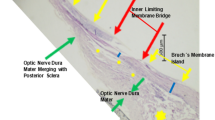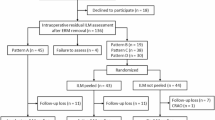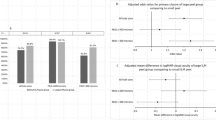Abstract
Purpose
To assess the stiffness of the natural human internal limiting membrane (ILM) and evaluate potential changes of the mechanical properties following staining with brilliant blue (BB) and indocyanine green (ICG).
Methods
Unstained ILM specimens were obtained during ophthalmic surgical procedures. After removal, the specimens were dissected into five parts. Two fragments were stained with BB and ICG, respectively, for 1 min, another two specimens were stained similarly followed by additional subsequent illumination using a standard light source (PENTA LUX x 50, Ophthalmologische Systeme GmbH Fritz Ruck). The fifth part served as an untreated control. All specimens were then analyzed using atomic force microscopy (AFM) in contact mode with a scan rate of 0.6 Hz. Two scan regions of 10 × 10 μm were chosen and stiffness was determined by using AFM in a force spectroscopy mode. The force curves were plotted with a data rate of 5000 Hz. In all specimens both the retinal side and vitreal side were analyzed.
Results
Staining resulted in a significant increase in tissue stiffness. An increase was seen both for the vitreal (BB: P<0.001; ICG: P<0.01) and retinal side (BB: P<0.01; ICG: P<0.01), with the retinal side being significantly stiffer in all control and stained samples. Additional illumination after staining did further increase tissue rigidity in most samples but not significantly.
Conclusions
Staining significantly increases the stiffness of the human ILM. This might explain the fact that the stained ILM can be removed more easily and in larger fragments during vitreoretinal surgical procedures compared with unstained ILM.
Similar content being viewed by others
Log in or create a free account to read this content
Gain free access to this article, as well as selected content from this journal and more on nature.com
or
References
Brooks HL Jr . Macular hole surgery with and without internal limiting membrane peeling. Ophthalmology 2000; 107: 1939–1948.
Haritoglou C, Gass CA, Schaumberger M, Ehrt O, Gandorfer A, Kampik A . Macular changes after peeling of the internal limiting membrane in macular hole surgery. Am J Ophthalmol 2001; 132: 363–368.
Eckardt C, Eckardt U, Groos S, Luciano L, Reale E . Entfernung der membrane limitans interna bei Makulalöchern. Ophthalmologe 1997; 94: 545–551.
Park DW, Dugel PU, Garda J, Sipperley JO, Thach A, Sneed SR et al. Macular pucker removal with and without internal limiting membrane peeling: pilot study. Ophthalmology 2003; 110: 62–64.
Kadonosono K, Itoh N, Uchio E, Nakamura S, Ohno S . Staining of the internal limiting membrane in macular hole surgery. Arch Ophthalmol 2000; 118: 1116–1118.
Rodrigues EB, Meyer CH, Mennel S, Farah ME . Mechanisms of intravitreal toxicity of indocyanine green dye: implications for chromovitrectomy. Retina 2007; 27 (7): 958–970.
Yam HF, Kwok AK, Chan KP, Lai TY, Chu KY, Lam DS et al. Effect of indocyanine green and illumination on gene expression in human retinal pigment epithelial cells. Invest Ophthalmol Vis Sci 2003; 44 (1): 370–377.
Sato T, Ito M, Ishida M, Karasawa Y . Phototoxicity of indocyanine green under continuous fluorescent lamp illumination and its prevention by blocking red light on cultured Müller cells. Invest Ophthalmol Vis Sci 2010; 51 (8): 4337–4345.
Hillenkamp J, Dydykina S, Klettner A, Treumer F, Vasold R, Bäumler W et al. Safety testing of indocyanine green with different surgical light sources and the protective effect of optical filters. Retina 2010; 30 (10): 1685–1691.
Haritoglou C, Gandorfer A, Gass CA, Schaumberger M, Ulbig MW, Kampik A . Indocyanine green-assisted peeling of the internal limiting membrane in macular hole surgery affects visual outcome: a clinicopathologic correlation. Am J Ophthalmol 2002; 134: 836–841.
Tsuiki E, Fujikawa A, Miyamura N, Yamada K, Mishima K, Kitaoka T . Visual field defects after macular hole surgery with indocyanine green-assisted internal limiting membrane peeling. Am J Ophthalmol 2007; 143: 704–705.
Enaida H, Hisatomi T, Hata Y, Ueno A, Goto Y, Yamada T et al. Brilliant blue G selectively stains the internal limiting membrane/brilliant blue G-assisted membrane peeling. Retina 2006; 26: 631–636.
Ueno A, Hisatomi T, Enaida H . Biocompatibility of brilliant blue G in a rat model of subretinal injection. Retina 2007; 27: 499–504.
Januschowski K, Mueller S, Spitzer MS, Schramm C, Doycheva D, Bartz-Schmidt KU et al. Evaluating retinal toxicity of a new heavy intraocular dye, using a model of perfused and isolated retinal cultures of bovine and human origin. Graefes Arch Clin Exp Ophthalmol 2012; 250 (7): 1013–1022.
Remy M, Thaler S, Schumann RG, May CA, Fiedorowicz M, Schuettauf F et al. An in-vivo evaluation of brilliant blue G in animals and humans. Br J Ophthalmol 2008; 92: 1142–1147.
Rodrigues EB, Penha FM, Farah ME, de Paula Fiod Costa E, Maia M, Dib E et al. Preclinical investigation of the retinal biocompatibility of six novel vital dyes for chromovitrectomy. Retina 2009; 29 (4): 497–510.
Baba T, Hagiwara A, Sato E, Arai M, Oshitari T, Yamamoto S . Comparison of vitrectomy with brilliant blue G or indocyanine green on retinal microstructure and function of eyes with macular hole. Ophthalmology 2012; 119 (12): 2609–2615.
Halfter W, Dong S, Dong A, Eller AW, Nischt R . Origin and turnover of ECM proteins from the inner limiting membrane and vitreous body. Eye 2008; 22 (10): 1207–1213.
Sneddon IN . The relation between load and penetration in the axisymmetric boussinesq problem for a punch of arbitrary profile. Int J Engng Sci 1965; 3: 47–57.
Henrich PB, Monnier CA, Halfter W, Haritoglou C, Strauss RW, Lim RY et al. Nanoscale topographic and biomechanical studies of the human internal limiting membrane. Invest Ophthalmol Vis Sci 2012; 53 (6): 2561–2570.
Heegaard S, Jensen OA, Prause JU . Structure and composition of the inner limiting membrane of the retina. SEM on frozen resin-cracked and enzyme-digested retinas of Macaca mulatta. Graefes Arch Clin Exp Ophthalmol 1986; 224: 355–360.
Sebag J . Anatomy and pathology of the vitreo-retinal interface. Eye 1992; 6: 541–552.
Streeten BA . Disorders of the vitreous. In: Garner A, Klintworth GK (eds) Pathophysiology of Ocular Disease—A Dynamic Approach, part B. Marcel Dekker: New York, 1982; 1381–1419.
Candiello J, Balasubramani M, Schreiber EM, Cole GJ, Mayer U, Halfter W et al. Biomechanical properties of native basement membranes. FEBS J 2007; 274 (11): 2897–2908.
Halfter W, Candiello J, Hu H, Zhang P, Schreiber E, Balasubramani M . Protein composition and biomechanical properties of in vivo-derived basement membranes. Cell Adh Migr 2012; 7 (1): 64–71.
Gandorfer A, Haritoglou C, Gandorfer A, Kampik A . Retinal damage from indocyanine green in experimental macular surgery. Invest Ophthalmol Vis Sci 2003; 44: 316–323.
Wollensak G . Biomechanical changes of the internal limiting membrane after indocyanine green staining. Dev Ophthalmol 2008; 42: 82–90.
Wollensak G, Spoerl E, Wirbelauer C, Pham DT . Influence of indocyanine green staining on the biomechanical strength of porcine internal limiting membrane. Ophthalmologica 2004; 218 (4): 278–282.
Foote CS . Definition of type I and type II photosensitized oxidation. Photochem Photobiol 1991; 54: 659.
Andley U . Photooxidative stress. in Albert DM, Jakobiec F (eds) Principles and Practice of Ophthalmology. WB Saunders Co: Philadelphia, 1992; vol 1, pp 575–590.
Engelbrecht NE, Freeman J, Sternberg P Jr, Aaberg TM Jr, Aaberg TM Jr, Martin DF et al. Retinal pigment epithelial changes after macular hole surgery with indocyanine green-assisted internal limiting membrane peeling. Am J Ophthalmol 2002; 133: 89–94.
Uemura A, Kanda S, Sakamoto Y, Kita H . Visual field defects after uneventful vitrectomy for epiretinal membrane with indocyanine green-assisted internal limiting membrane peeling. Am J Ophthalmol 2003; 136: 252–257.
Engel E, Schraml R, Maisch T, Kobuch K, König B, Szeimies RM et al. Light-induced decomposition of indocyanine green. Invest Ophthalmol Vis Sci 2008; 49 (5): 1777–1783.
Haritoglou C, Gandorfer A, Gass CA, Schaumberger M, Ulbig MW, Kampik A . The effect of indocyanine-green on functional outcome of macular pucker surgery. Am J Ophthalmol 2003; 135: 328–337.
Kenawy N, Wong D, Stappler T, Romano MR, Das RA, Hebbar G et al. Does the presence of an epiretinal membrane alter the cleavage plane during internal limiting membrane peeling? Ophthalmology 2010; 117 (2): 320–323.
Gandorfer A, Schumann R, Scheler R, Haritoglou C, Kampik A . Pores of the inner limiting membrane in flat-mounted surgical specimens. Retina 2011; 31 (5): 977–981.
Acknowledgements
We thank Renate Scheler, TA, for her excellent technical support (as usual).
Author information
Authors and Affiliations
Corresponding author
Ethics declarations
Competing interests
The authors declare no conflict of interest.
Rights and permissions
About this article
Cite this article
Haritoglou, C., Mauell, S., Benoit, M. et al. Vital dyes increase the rigidity of the internal limiting membrane. Eye 27, 1308–1315 (2013). https://doi.org/10.1038/eye.2013.178
Received:
Accepted:
Published:
Issue date:
DOI: https://doi.org/10.1038/eye.2013.178
Keywords
This article is cited by
-
Biomechanical properties of retina and choroid: a comprehensive review of techniques and translational relevance
Eye (2021)
-
Outcomes of vitrectomy combined with subretinal tissue plasminogen activator injection for submacular hemorrhage associated with polypoidal choroidal vasculopathy
Japanese Journal of Ophthalmology (2019)
-
Macular peeling-induced retinal damage: clinical and histopathological evaluation after using different dyes
Graefe's Archive for Clinical and Experimental Ophthalmology (2018)
-
An evaluation of two heavier-than-water internal limiting membrane-specific dyes during macular hole surgery
Graefe's Archive for Clinical and Experimental Ophthalmology (2016)



